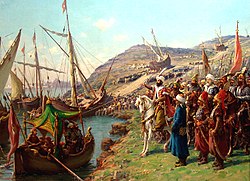Fall of Constantinople

The Fall of Constantinople occurred when the Ottoman Empire took over Constantinople, the capital city of the Byzantine Empire, on 29 May 1453.[1] The Ottomans were commanded by 21-year-old Ottoman Sultan Mehmed II, who defeated an army commanded by Byzantine Emperor Constantine XI Palaiologos. The conquest of Constantinople followed a 53-day siege started on 6 April 1453. After the conquest of the city, Constantinople became the capital of the Ottoman Empire. Today, Constantinople is known as Istanbul.
This event marks the end of the Byzantine Empire, and so it was the end of the Roman Empire, which had lasted for nearly 1,500 years.[2] Previous Ottoman Sultans had taken most of the Empire in previous centuries. Some places, like the Morea Despotate and Empire of Trebizond were not defeated by the Ottomans until several years later.
The fall of Constantinople had important results, because the Ottoman Empire at last had control of the Balkans. Nothing could stop them from further Muslim conquests into Europe, which went on until after the Battle of Vienna in 1683. After the fall of Constantinople and the Byzantine Empire, many refugees escaped to Western Europe and helped create humanism. In particular, the arrival in Italy of Greek scholars is said to have helped the Renaissance.[3]
Fall Of Constantinople Media
The chain that closed off the entrance to the Golden Horn in 1453, now on display in the İstanbul Archaeology Museums.
The Dardanelles Gun, cast by Munir Ali in 1464, is similar to bombards used by the Ottoman besiegers of Constantinople in 1453 (British Royal Armouries collection).
Modern painting of Mehmed and the Ottoman Army approaching Constantinople with a giant bombard, by Fausto Zonaro.
Painting of the Fall of Constantinople, by Theophilos Hatzimihail
Painting by Fausto Zonaro depicting the Ottoman Turks transporting their fleet overland into the Golden Horn.
Painting by the Greek folk painter Theophilos Hatzimihail showing the battle inside the city, Constantine is visible on a white horse
Following the city's conquest, the Church of the Holy Wisdom (the Hagia Sophia) was converted into a mosque.
References
- ↑ "неколико одломака Georgie Sfrances, Chronic". Archived from the original on 2012-01-23. Retrieved 2009-06-14.
- ↑ Momigliano, Arnaldo & Schiavone, Aldo 1997. Storia di Roma, 1, Introduction. Turin: Einaudi (in Italian). ISBN 88-06-11396-8
- ↑ "Melissa Snell, The Forgotten Empire". Archived from the original on 2012-11-18. Retrieved 2009-06-14.









